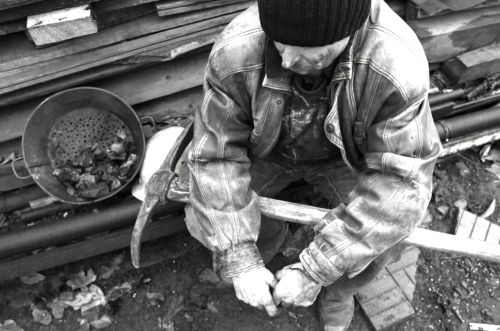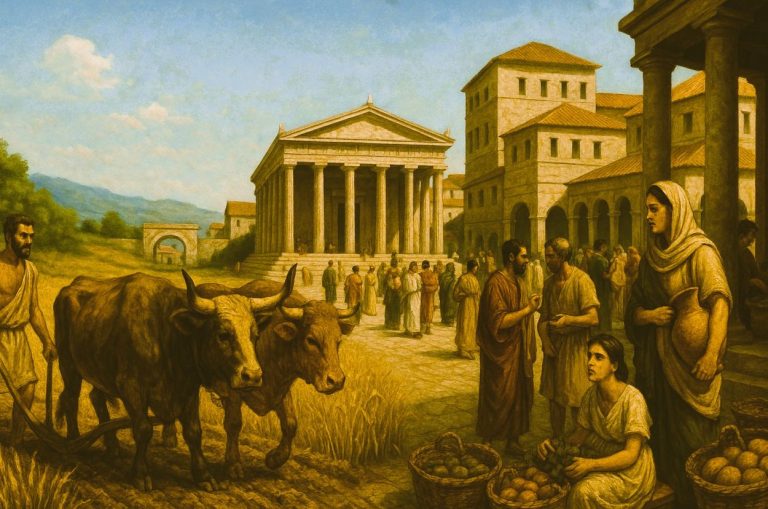

The middle class is not a luxury of prosperity; it is the architecture of democracy. When that structure weakens, everything built upon it begins to tilt.

By Matthew A. McIntosh
Public Historian
Brewminate
Introduction
The American middle class, once the stabilizing force between wealth and want, is dissolving into history’s long pattern of imbalance. Census and Pew Research Center data reveal what millions already feel in their daily lives: a gradual but relentless erosion of security, mobility, and voice. In 1971, six in ten adults lived in middle-income households; today, barely half do. The share of national income they hold has fallen from nearly two-thirds to less than half, while the top tier now controls unprecedented wealth and political influence.
Behind these numbers lies a deeper story about democracy’s fragility. The middle class once provided ballast; its relative comfort, civic participation, and moderation kept American politics from veering into either plutocracy or populist fury. As that center thins, the republic begins to tilt. Economic power concentrates upward, social trust fractures downward, and faith in equal opportunity fades across generations.
What emerges is not simply inequality, but imbalance, a structural distortion that history has seen before. From the late Roman Republic to the Gilded Age, societies that allowed such divides to widen often found their public institutions hollowed and their civic spirit consumed. The United States now stands uncomfortably close to that precipice, where prosperity narrows into privilege and democracy begins to feed on itself.
The Numbers behind the Decline
Measured across five decades, the numbers are stark. According to the Pew Research Center, the share of adults in middle-income households has fallen from 61 percent in 1971 to about 50 percent in 2021, while the upper-income tier has more than doubled in size. The portion of aggregate income held by the middle class dropped from roughly 62 percent to just 43 percent, marking a historic transfer of economic weight toward the top.
Federal Reserve data show that by 2023, the top 10 percent of Americans owned nearly 70 percent of total household wealth, leaving the middle class with about one-quarter. The U.S. Census Bureau’s 2022 income report confirms that median household income, adjusted for inflation, declined by 2.3 percent from the previous year, continuing a pattern of stagnation even as corporate profits and stock valuations rose sharply.
International comparisons suggest the same structural drift. The Organization for Economic Co-operation and Development finds that income growth among the richest 10 percent has far outpaced median earnings in every advanced democracy since the 1990s. In the United States, the gap has widened fastest, driven by wage polarization, automation, and asset inflation. The numbers tell a clear story: the economic heart of the nation is contracting while the extremes swell, and with them, the political and social instability that inequality breeds.
Stagnation and the Cost Squeeze
For millions of Americans who still identify as middle class, stability has become a moving target. After two decades of rising productivity without matching wage growth, purchasing power has eroded even during periods of economic expansion. The U.S. Census Bureau reports that inflation-adjusted earnings have hovered near the same level since the early 2000s, a stagnation that leaves most households no better off than their parents were a generation ago.
Housing costs tell the story most clearly. According to the Federal Reserve Bank of St. Louis, home prices surged more than 45 percent between 2019 and 2023, while rents rose by double digits nationwide. What was once the cornerstone of middle-class identity, home ownership, has become a competitive market tilted toward investors and high-income buyers. Younger families are increasingly locked out, forced into long-term renting that prevents the accumulation of equity or stability.
Health care and education have followed similar trajectories. The Kaiser Family Foundation found that annual premiums for employer-sponsored health insurance climbed 7 percent in 2023 alone, pushing the average family plan above $24,000. Tuition and fees at public universities have risen by more than 180 percent since 1990, even after adjusting for inflation. The combined burden of medical bills, student debt, and rising living costs has consumed what little income growth the middle class once enjoyed.
The result is a class suspended between comfort and crisis. Many earn too much to qualify for assistance yet too little to build savings or wealth. The promise that effort alone guarantees progress has weakened under the weight of bills, debt, and volatility. Beneath the economic data lies a moral one: a society where diligence no longer assures security risks losing not only prosperity but faith in its own fairness.
Economic Polarization and Political Power
The widening gulf between rich and poor has become the quiet architect of American politics. Wealth, once the reward of enterprise, now operates as an instrument of governance, reshaping how laws are written, campaigns are funded, and agendas are set. The Federal Reserve’s Distributional Financial Accounts trace an accelerating consolidation of assets at the top, translating directly into outsized political leverage.
Money has always spoken in Washington, but in recent decades it has learned to shout. The top one percent of donors now supply the majority of federal campaign funds, financing super PACs and issue groups that define entire election cycles. The average voter may still cast a ballot, but policy priorities are increasingly brokered long before that ballot is counted, inside think tanks, lobbying firms, and donor retreats where access is capital itself.
The collapse of organized labor has magnified the imbalance. The U.S. Bureau of Labor Statistics reports union membership at just ten percent, its lowest level on record. Where unions once amplified the collective bargaining power of millions, fragmented gig work and anti-organizing laws have left individuals to negotiate alone. Without that counterweight, wage stagnation persists and worker influence on policy evaporates.
These economic and institutional shifts form a reinforcing cycle. As concentrated wealth funds political campaigns, those campaigns advance tax codes and deregulation that protect concentrated wealth. Princeton and Northwestern research has shown that government outcomes consistently mirror elite preferences while barely reflecting the opinions of average citizens. Democracy, in effect, begins to mimic the market, responsive to capital, indifferent to consensus.
The effects are visible well beyond the capital. Civic participation declines as trust erodes, and communities that once relied on middle-class engagement retreat from public life. School boards, town councils, and local newspapers, traditional engines of democratic practice, are thinning out along the same lines as economic opportunity. The more wealth dictates representation, the fainter the republic’s middle voice becomes, leaving the nation governed by its extremes rather than its center.
Social Trust and Democratic Stability
The collapse of economic balance has left its imprint on public faith. Gallup’s long-running confidence survey shows that trust in Congress has sunk, while confidence in the Supreme Court and the presidency has also fallen sharply. When citizens believe that rules are written for others, the democratic covenant erodes. Institutions that once embodied fairness (courts, schools, media, elections) begin to appear as instruments of privilege rather than guardians of equality.
The Organization for Economic Co-operation and Development warns that income polarization correlates closely with civic withdrawal: people disengage from politics, volunteerism declines, and social cohesion weakens. In the United States, that dynamic now defines much of civic life. Voter participation remains higher among affluent citizens, while turnout among lower-income and middle-income groups continues to slide. Neighborhoods stratify by wealth, education, and race, and the shared spaces that once bridged class divides, from unions to local newspapers, have thinned or vanished altogether.
What emerges is a nation still governed by democratic form but hollowed of democratic substance. The social fabric that once bound Americans through mutual obligation has frayed under economic strain, replaced by isolation, suspicion, and cynicism. Restoring trust requires more than policy adjustments; it demands a renewal of the middle itself, a broad, confident public capable of believing again that the republic belongs to everyone, not merely those who can afford to steer it.
Historical Parallels and the Cycle of Revolt
History rarely repeats itself precisely, but it rhymes with unsettling clarity. The late Roman Republic saw its small farmers displaced by vast estates owned by the wealthy elite, a transformation that hollowed out civic virtue and fueled class conflict. Economic imbalance then, as now, eroded the sense of shared stake that sustains self-government. When wealth hardened into hierarchy, populist movements rose promising restoration and paved the road to empire.
Modern industrial democracies have followed similar arcs. The OECD’s inequality data show that nations with strong middle classes maintain higher political stability and lower rates of extremism. Conversely, when wages stagnate and social mobility collapses, polarization accelerates. Europe’s upheavals in the late nineteenth and early twentieth centuries, from labor revolts to the emergence of authoritarian regimes, were born from the same breach between rich and poor that now widens across the United States.
America has survived such reckonings before. The Gilded Age concentrated wealth to extraordinary levels, prompting the Progressive reforms of the early twentieth century. The New Deal later rebuilt a broad middle class through labor rights, social insurance, and investment in public infrastructure. Those eras demonstrated that inequality is not destiny; collective action can reassert equilibrium when imbalance threatens democracy’s survival.
Today, the country stands at another inflection point. The economic forces reshaping American life (automation, global finance, and corporate consolidation) mirror older patterns of accumulation but with digital speed and global reach. Whether the nation responds with renewal or resignation will decide more than its prosperity; it will determine whether the republic remains a shared endeavor or devolves into a managed hierarchy. The lessons of history are not abstract warnings; they are blueprints, reminding a faltering democracy that balance, once lost, must be deliberately restored.
Conclusion
The middle class is not a luxury of prosperity; it is the architecture of democracy. When that structure weakens, everything built upon it begins to tilt. The Pew Research Center notes that America’s economic center is now smaller than at any time since World War II, even as the nation’s overall wealth has reached record highs. The contradiction defines our era: abundance without balance, growth without security.
History suggests that republics rarely die from conquest; they unravel from within, when inequality corrodes solidarity and cynicism replaces trust. The collapse of a broad middle transforms citizens into spectators, watching decisions made elsewhere by people they will never meet. Without shared economic footing, even the language of “common good” loses meaning.
Restoring that balance will not come through nostalgia or slogans but through deliberate reconstruction, policies that expand opportunity, rebuild civic trust, and reward work as much as wealth. The middle class remains the nation’s quiet majority, its stabilizing gravity. If America allows it to vanish, it will not merely lose a social tier; it will lose the balance that makes self-government possible.
Originally published by Brewminate, 10.29.2025, under the terms of a Creative Commons Attribution-NonCommercial-NoDerivatives 4.0 International license.


